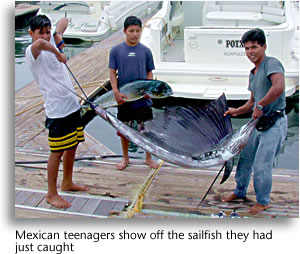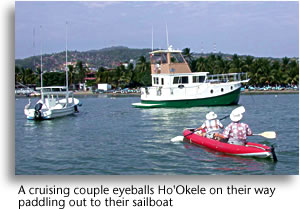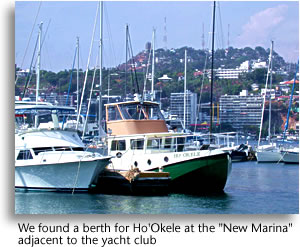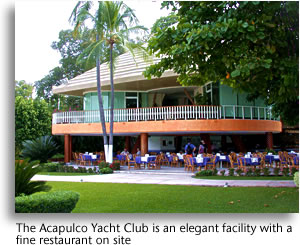|
Westward Ho’Okele: Dispatch 9
Cruising from A to Z (not B)
By Peter Swanson
Cruising from port-to-port along the Central American and Mexican coasts certainly reinforced the fact that there’s no such thing as a two-day turnaround in the developing world. Clearing in and clearing out, arranging for fuel, modest provisioning and quick sightseeing take a minimum of three days, and Ho’Okele’s visit to Acapulco was no exception.
It still bothered me, however, because I had long ago learned another truism: “Time in port rots men and ships.”
And though the delivery of Ho’Okele was a great opportunity to make myself an expert on what I feel is my company’s best product, not to mention see the world, this voyage was nonetheless a delivery, with the boat’s owner waiting anxiously in Hawaii for his new boat.
 The success of a delivery is measured by how quickly and unproblematically a vessel is moved from point A to point B. The best delivery skipper is often the guy who smashes into six-foot seas for days straight eating only peanutbutter sandwiches and drinking Gatorade to reach point B before that plane lands with the boat’s owner and his vacationing family. The success of a delivery is measured by how quickly and unproblematically a vessel is moved from point A to point B. The best delivery skipper is often the guy who smashes into six-foot seas for days straight eating only peanutbutter sandwiches and drinking Gatorade to reach point B before that plane lands with the boat’s owner and his vacationing family.
The problem with that approach is that it leaves nothing to write short of a disaster at sea or a crewmember morphing into a madman/woman. It was for this reason, when I was a magazine editor, that I reacted skeptically to stories offered by delivery skippers. If they were any good at their jobs, they’d have nothing worthwhile to write about.
For me, however, time in port was necessary to gather fodder for these dispatches. Plus I needed to keep my volunteer crew happy. So I was torn between my dual roles. And Acapulco, the over-the-top pleasure capital of Mexico, exacerbated my sense of guilt. (By now my co-workers in Gainesville are surely rolling their eyes and thinking “Yeah right! Who’s he kidding?”)
All this is my way of getting to the point, which is that the crew of Ho’Okele spent four days in Acapulco, during which time we entertained my friend Barbara from Jacksonville, who popped down for a visit.
Even so I can’t say I really know much about Acapulco, a teeming resort of 3 million people, but I can report on the facilities for visiting cruisers.
 Chef Charles and I arrived at night, as we always seem to do, with the help of our friends Furuno and C-Map. And as always, we intended to anchor. The bottom drops off sharply in the harbor so we idled over to the Acapulco Yacht Club and dropped the hook in the shallowest place we could find, a mooring field in 50 feet of water. Chef Charles and I arrived at night, as we always seem to do, with the help of our friends Furuno and C-Map. And as always, we intended to anchor. The bottom drops off sharply in the harbor so we idled over to the Acapulco Yacht Club and dropped the hook in the shallowest place we could find, a mooring field in 50 feet of water.
In the morning I radioed the yacht club, which has more than 300 berths and caters to Mexico’s wealthy elite. No room at the inn, the dockmaster politely informed me. Would I care to get on a waiting list? Perhaps, he said, a slip would materialize by Saturday, four days hence.
Never mind, I said. Is there another place to dock a boat? He said I could try the “New Marina” next door.
I got no answer hailing New Marina. But I did get a reply from a cruiser, who had obviously not overheard my conversation with the Yacht Club or could not understand our Spanish. Mr. Helpful fit my first-guy-on-the-radio stereotype perfectly. The first guy on the radio is usually the guy in the harbor who knows the least about the matter at hand . .
First he informed me that there was no facility in Acapulco called the New Marina. There were some disintegrating docks next door to the Yacht Club, but the owners weren’t taking any transients. We would have to suffer as he had, anchored in 60-feet of water, and gnash our teeth when it blew like stink as it had the night before.
I paddled our little inflatable over to the docks in question. The dockmaster apologized for not having a VHF, and said we could have a slip for a few nights no problema, as long as we were willing to pay 50 cents a foot. Mr. Helpful had been right about one thing, however. The wooden docks were in shambles, broken and rotten planks were kept from drifting away by crude polypropelene lashes. Still, the shoreside facility was in fine shape (including a nice swimming pool), the staff friendly and the security good. Welcome to Acapulco.
 We walked over to the Yacht Club, where the Port Captain maintains a satellite office, to “clear in” to Acapulco, even though we had already cleared in to Mexico when we arrived at Huatulco. The club was a beautiful world-class facility, with manicured grounds, statuary and a shady open-air restaurant. Here, too, was in the only fuel dock in the city. The boats, mostly of the sportfish variety, were med-moored to both concrete piers and floating docks. A concrete breakwater provided a breakwater against the Pacific surge. Had there been room, the price would have been a buck a foot. There is a small but well stocked marine store on the grounds. We walked over to the Yacht Club, where the Port Captain maintains a satellite office, to “clear in” to Acapulco, even though we had already cleared in to Mexico when we arrived at Huatulco. The club was a beautiful world-class facility, with manicured grounds, statuary and a shady open-air restaurant. Here, too, was in the only fuel dock in the city. The boats, mostly of the sportfish variety, were med-moored to both concrete piers and floating docks. A concrete breakwater provided a breakwater against the Pacific surge. Had there been room, the price would have been a buck a foot. There is a small but well stocked marine store on the grounds.
Back on our docks, Chef Charles struck up a conversation with an old guy, who had been cleaning boat bottoms in Acapulco since the days of Errol Flynn. He was a little guy and his wrinkled face was made even more interesting by the permanent oval impression left by his diving mask, which was his only equipment other than a scrapper. He was incredibly fit for his age, tough as wet leather.
Once, he said, the area around the yacht club and the hills behind comprised Acapulco in its entirety, in the days when European royalty and Hollywood stars came here to cavort away from their courtiers and gossip columnists. None of the high-rise hotels that lined the beach opposite existed, he said.
|





